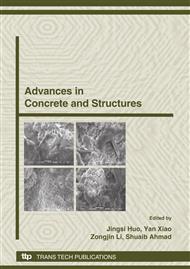p.251
p.257
p.263
p.269
p.275
p.281
p.287
p.295
p.301
Shear Capacity of Reinforced Concrete Beams under Biaxial Bending Based on Equivalent Cross-Section Method
Abstract:
Based on the analysis of reinforced concrete beams under biaxial bending, an equivalent cross-section method is proposed to calculate the shear capacity of the beams. According to the two basic equivalence principles, a biaxial flexural beam is changed into a uniaxial flexural member, and the shear strength of biaxial flexural beam is calculated as a uniaxial flexural member. Furthermore, the interrelationships among the equivalent cross-section and the neutral axis inclination as well as the ratio of depth to width of the cross-section are deduced in advance. The ratios of some typical cross-section’s equivalent dimensions to its original ones are pointed also. In order to verify the availability of the equivalent cross-section method, some academic references about the ultimate strength of biaxial flexural beams are consulted in this paper, and the shear capacity computing methods by literatures for uniaxial flexural beams are adopted in the strength calculation of biaxial flexural reinforced concrete simply supported beams with stirrups or without stirrups. The comparison between the calculation results and experimental results shows that the presented equivalent cross-section method is feasible and practical which can be used as a reference in practice design.
Info:
Periodical:
Pages:
275-280
Citation:
Online since:
October 2008
Authors:
Price:
Сopyright:
© 2009 Trans Tech Publications Ltd. All Rights Reserved
Share:
Citation:


